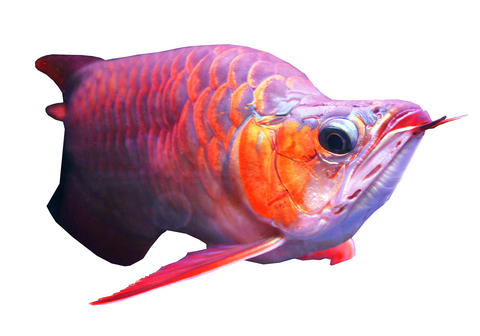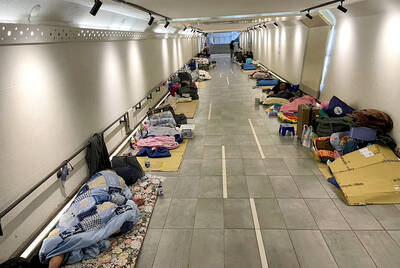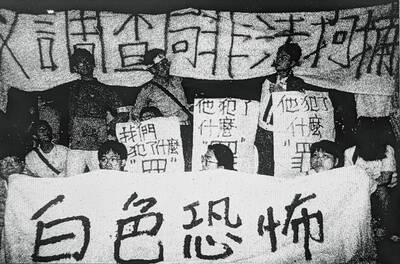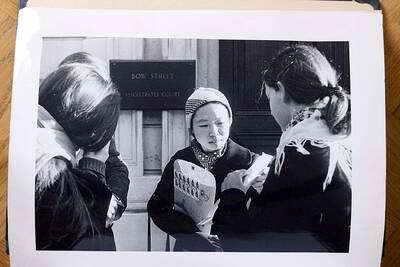Gingerly removing a black cloth from his aquarium, Erfin Hongdoyo beams as he unveils one of his most treasured possessions - a large, red and very rare arowana fish.
The ethnic Chinese Indonesian man is proud owner of a 45cm scleropages formosus, a freshwater fish native to the wilds of Indonesian Borneo, which is nearing extinction.
While the so-called "super red" arowana is disappearing in nature, demand for the undulating fish is booming among Asia's rich.

PHOTO: AFP
And although breeding is only permitted in three countries - Indonesia, Malaysia and Singapore - the arowana's growing popularity as a symbol of newfound wealth could be what saves it from extinction.
"I think it looks like a dragon," says Hongdoyo, adding he would not part with the fish for less than US$3,300 to US$4,400.
That's nowhere near the top of the price scale as speculation has seen some arowanas change hands for as much as US$55,000.
A recent fair dedicated to arowanas in Indonesia's capital ended with sales equivalent to US$20,000 dollars for one fish and US$22,100 dollars for another, said Stephen Suryaatmadja, founder and chairman of the Indonesian Arowana Club.
The fair had a special room with around 50 "super red" contestants, kept under 24-hour guard and with a total estimated value of more than US$1 million.
Breeders say demand for arowanas, which appear on the World Conservation Union's (IUCN) red list of threatened species, is on the rise in China, Japan, Taiwan and India.
Its popularity is all about looks, as the Chinese believe it resembles a dragon and symbolizes good health, luck, prosperity, family harmony and protection against evil. Others believe the arowana has supernatural powers, or that it is a symbol of wealth and refinement, much like a work of art.
It's not just the Chinese who are shelling out huge sums for the fish.
The arowana's appeal has led to the establishment of specialized fish farms, some of which are publicly listed and run by powerful businessmen.
"There is more and more competition," says Jap Khiat Bun, director of Jakarta's CV Maju Aquarium, adding that there are now more than 200 breeders in Pontianak, on Borneo island, alone.
Arowana are difficult to breed and breeders must register with the Convention on International Trade in Endangered Species of Wild Fauna and Flora. Each captive-bred fish must be sold with an accompanying certificate showing it to be at least a second-generation captive fish. Each is also implanted with a microchip so it can be identified at all times.
Despite these precautions, the fever for arowanas is generating a "very high level of smuggling," says Chris Shepherd, a regional program officer with TRAFFIC Southeast Asia, a group that monitors the wildlife trade.
"The profit margins are really high and therefore there are a lot of illegal captures to sustain the illegal trade," he says. "The populations are rapidly declining. It's a very urgent situation and I don't see any sign of the trade getting smaller."
Laurent Pouyaud, a Jakarta-based genetic expert from the French Institute of Research for Development, agrees the red arowana is nearly extinct in Indonesia, and says it has probably already been wiped out in Thailand.
"There are almost no more (in the wild)," says Pouyaud, adding that the remaining habitat in Borneo covers less than 100 hectares.
Arowanas, which are insect-eaters, are able to jump to a height of 1.5m and can be easily captured, explains Pouyaud. "Their eyes glow not far from the surface and they can be caught with a net."
According to one of the five international judges at the fair, Hendri Leong, discerning which arowana is best is a subtle process.
Color and body shape each account for 30 percent of the final mark, while the remaining 40 percent is worked out on the tail, fins and mouth.
A prime arowana's eyes must naturally look upwards, because it is supposed to be on the lookout for insects. The two barbels - whiskery protrusions from the front of the jaw - must run parallel to each other and the fins must be well shaped and intact.
An arowana that has a single row of scales along the crest of its back, rather than splitting in two at the gills, is declared I Thiaw Long, or "dragon in the dark," and its value immediately doubles.
According to arowana club chairman Suryaatmadja, famous fish are starting to generate reputations similar to racehorses.
The "grand champion Singapore 2007" was named Oscar de la Hoya, after the famous American boxer. Its owner was offered the price of a new Mercedes-Benz for the fish but turned it down.
The craze for arowanas means rarity is sought out in all its forms. A Siamese-twin arowana, its two bodies joined on one side, which prevents it from swimming, is kept alive by an owner who hand feeds it.
Some albino or "platinum" arowanas have also gone at times for higher prices than the "super red" variety, as they are much more rare.
Arowana mania has also been a boon for fraudsters, with some feeding non-red arowanas with hormone-injected grasshoppers to give the fish the valuable hue.
The fish is also associated with power. Suryaatmadja said that Indonesian President Susilo Bambang Yudhoyono had just bought a "super red."
The late former dictator Suharto was also reputed to own one, which he called "the thinking arowana." The fish, according to legend, was a silent consultant for the strongman when it came time to make difficult decisions.

From the last quarter of 2001, research shows that real housing prices nearly tripled (before a 2012 law to enforce housing price registration, researchers tracked a few large real estate firms to estimate housing price behavior). Incomes have not kept pace, though this has not yet led to defaults. Instead, an increasing chunk of household income goes to mortgage payments. This suggests that even if incomes grow, the mortgage squeeze will still make voters feel like their paychecks won’t stretch to cover expenses. The housing price rises in the last two decades are now driving higher rents. The rental market

July 21 to July 27 If the “Taiwan Independence Association” (TIA) incident had happened four years earlier, it probably wouldn’t have caused much of an uproar. But the arrest of four young suspected independence activists in the early hours of May 9, 1991, sparked outrage, with many denouncing it as a return to the White Terror — a time when anyone could be detained for suspected seditious activity. Not only had martial law been lifted in 1987, just days earlier on May 1, the government had abolished the Temporary Provisions Effective During the Period of National Mobilization for Suppression of the Communist

Fifty-five years ago, a .25-caliber Beretta fired in the revolving door of New York’s Plaza Hotel set Taiwan on an unexpected path to democracy. As Chinese military incursions intensify today, a new documentary, When the Spring Rain Falls (春雨424), revisits that 1970 assassination attempt on then-vice premier Chiang Ching-kuo (蔣經國). Director Sylvia Feng (馮賢賢) raises the question Taiwan faces under existential threat: “How do we safeguard our fragile democracy and precious freedom?” ASSASSINATION After its retreat to Taiwan in 1949, the Chinese Nationalist Party (KMT) regime under Chiang Kai-shek (蔣介石) imposed a ruthless military rule, crushing democratic aspirations and kidnapping dissidents from

Fundamentally, this Saturday’s recall vote on 24 Chinese Nationalist Party (KMT) lawmakers is a democratic battle of wills between hardcore supporters of Taiwan sovereignty and the KMT incumbents’ core supporters. The recall campaigners have a key asset: clarity of purpose. Stripped to the core, their mission is to defend Taiwan’s sovereignty and democracy from the Chinese Communist Party (CCP). They understand a basic truth, the CCP is — in their own words — at war with Taiwan and Western democracies. Their “unrestricted warfare” campaign to undermine and destroy Taiwan from within is explicit, while simultaneously conducting rehearsals almost daily for invasion,